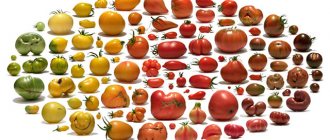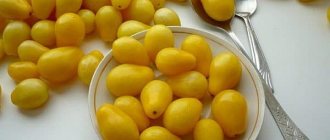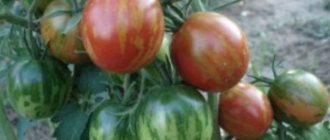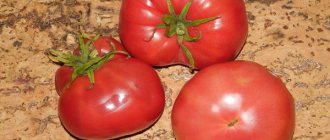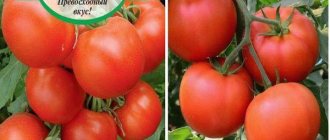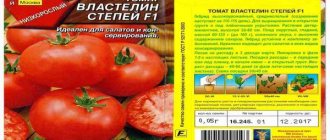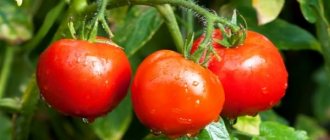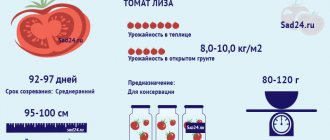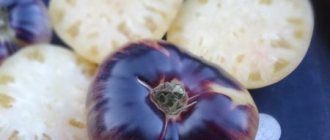The Honey Bunch tomato fully corresponds to its name - its fruits are sweet, like honey, aromatic and tasty. In addition, low bushes, decorated with clusters of bright yellow berries, can serve as an ornamental plant.
| Height | Landing location | Ripening time | Fruit color | Fruit size | Origin | Fruit shape |
| short | Greenhouse, Open ground | Early ripening | Yellow | Small | Variety | Round |
Tomato Amber Cup - description and characteristics of the variety
Our online calorie calculator will calculate the calories, proteins, fats and carbohydrates of your most favorite dishes and products.
The lunar calendar for 2021 will reveal to you its secrets of success, wealth, and good luck in love. This variety with the sonorous name “Amber Cup” caused a real storm of rejoicing among summer residents and gardeners. Thanks to many years of efforts of breeders, it embodies high yields, excellent taste of fruits and high commercial characteristics.
A plus to everything is its resistance to diseases and adverse weather conditions.
Characteristics and features of the variety
Tall (indeterminate) type of tomato. Registered in the State Register of Varieties of Russia. The habit of the bush is powerful, with an average height of 1.5–1.8 m, well leafy.
The fruits of this variety are very dense, with thick walls, resistant to mechanical deformation. They are smooth, without pronounced ribbing. When fully ripe, it has a beautiful, rich orange-yellow, or rather amber-golden color. Medium-sized tomatoes, 100-130 g, rectangular-round shape. Simply put, the shape of the fruit is “cream”. Tomatoes are collected in open clusters of 6-8 fruits.
Despite the significant density of the fruit, the pulp of the variety is tender, aromatic, and moderately juicy. The tomatoes are tasty and sweet. The skin is thin, but strong, elastic, and resistant to cracking.
Application
Fruits of universal use. Suitable for the now popular stuffing of tomatoes, whole-fruit canning, for freezing separately or as part of a vegetable mix. Excellent for fresh consumption and preparing various salads. And also for grilling and all types of processing (sauces, ketchups, tomato paste).
Strengths of the variety
- Resistance to negative external factors.
- The variety has good vigor, open clusters, and the fruits are easy to pick.
- Suitable for growing in open and protected ground conditions.
- High yields: in protected soil conditions - up to 10 kg per 1 sq. m.
And when grown in open ground - up to 4-5 kg.
- Successful tolerance of minor frosts and temperature changes.
- Ability to set fruit well in very hot weather.
- Resistance to major diseases and pests of nightshade crops. In particular to fusarium and verticillium.
- Consistently high commercial characteristics of the fruit. Original color of tomatoes.
- High shelf life and transportability of fruits.
- Capable of long-term (up to 2) months storage.
- The bushes are resistant to rotting if the correct temperature and humidity conditions are observed.
Secrets of successful cultivation of the variety
- Planting - no more than 3-4 plants per 1 sq.m. It is necessary to avoid thickening of plantings and ensure their good ventilation. Especially in protected ground conditions.
- Compliance with the planting scheme: 40-50 cm between plants in a row, row spacing - 1 m.
- Formation of a bush of 2-3 strong shoots.
- Planting in well-lit areas.
- Carrying out several preventive treatments using plant protection products (plant protection products).
- Removing the lower leaves on the stems, removing the stepsons every 10 days.
- Planting seedlings in the ground at the age of 60-65 days.
- Tie to a trellis or support a few days after planting the seedlings in the soil.
- Carrying out regular sanitary cleaning and maintaining a high agricultural background.
- Adding rotted manure to the soil. Regular fertilizing with complex mineral fertilizers. Treatment frequency is 10-14 days.
- Alternating spraying with a fertilizer solution on the leaf with watering at the root.
- Sowing seeds for seedlings in late February/early March.
- Water the seedlings with warm water, avoiding moisture on the foliage.
- Using a high-quality, nutritious substrate for growing seedlings that does not contain insect larvae and spores of harmful fungi.
The taste that children and adults love is the Honey Bunch tomato: a full description of the variety
The Honey Bunch tomato fully corresponds to its name - its fruits are sweet, like honey, aromatic and tasty. In addition, low bushes, decorated with clusters of bright yellow berries, can serve as an ornamental plant.
| Tasting qualities | Tomatoes have a balanced sweet and sour taste that is not lost during preservation, which is especially popular among consumers |
| Marketability | High. The elasticity of the fruit allows tomatoes to be transported over long distances and also stored for a long time. |
| Maturation | The variety is early ripening and has the ability to bear fruit for a long time. So on one bunch you can see tomatoes with different degrees of ripeness |
| Productivity | From one bush you can take up to 3 kg of tomatoes per season, from 1 sq.m. – about 7 kg |
| Frost resistance | Does not tolerate low temperatures well |
| Immunity | In drafts, the variety is susceptible to late blight |
| Height | Landing location | Ripening time | Fruit color | Fruit size | Origin | Fruit shape |
| short | Greenhouse, Open ground | Early ripening | Yellow | Small | Variety | Round |
Description and characteristics of the variety
Description of fruits: ripen 90-105 days after germination of plantings. Each cluster contains about 8 small bright yellow tomatoes weighing 30-50 g. They are round, with 2 chambers with seeds inside. The taste is sweet, honey. The pulp is tender and juicy. Can be used for any dishes, processing, fresh salads and table decoration.
Advantages and disadvantages
- Sweet pleasant taste;
- Beautiful appearance and decorative qualities;
- Cold resistance;
- Fast ripening;
- Good yield;
- Universal use;
- Easy to care for, there is no requirement to root out the bush;
- The plant is resistant to verticillium and produces a harvest before the outbreak of late blight.
Minuses:
- Short shelf life of fruits.
Productivity
Under film with 1 sq.m. you can get 5 kg of fruit.
Landing
Tomato seeds treated with potassium permanganate solution are sown for seedlings in March. They are also etched in a solution of a growth stimulator. Seedlings are grown on a windowsill at a temperature of +18-22 for 55-60 days.
4-5 bushes per 1 sq.m. are placed in a permanent place.
Characteristics and description of the Sweet Bunch variety with photo
“Sweet Bunch” is a fairly young variety, recorded in domestic registers only in 2009. Russian breeders tried to create a product that satisfies almost all requirements. The main characteristics can be presented as follows:
Table 1
Features of “Sweet Bunch” tomatoes
| Characteristics | Description |
| Bush | Indeterminate, with continuous growth (more than 2.5 m), which must be stopped in open ground at a height of 1.8 m. In cultivated structures, the limiter is the greenhouse roof The plant is well leafed with dark green large plates |
| Fruit | Dense, round, with smooth, deep red skin. Small seeds are evenly distributed into 2 nests. Tomatoes are formed in long clusters of 20-25 pieces, and each fruit weighs on average 30 g. |
| Tasting qualities | Tomatoes have a balanced sweet and sour taste that is not lost during preservation, which is especially popular among consumers |
| Marketability | High. The elasticity of the fruit allows tomatoes to be transported over long distances and also stored for a long time. |
| Maturation | The variety is early ripening and has the ability to bear fruit for a long time. So on one bunch you can see tomatoes with different degrees of ripeness |
| Productivity | From one bush you can take up to 3 kg of tomatoes per season, from 1 sq.m. – about 7 kg |
| Frost resistance | Does not tolerate low temperatures well |
| Immunity | In drafts, the variety is susceptible to late blight |
According to consumer requests, “Sweet Bunch” is considered universal. Tomatoes are good in salads, canned food, for making juices, purees, and sauces.
Characteristics of the variety
Tomatoes of this variety are early, their ripening period ranges from 95 to 105 days from the moment of emergence. The height of the bush reaches from half a meter to 70 centimeters. The leaves are dark green, small.
The characteristics of the fruit indicate that tomatoes are distinguished by their flat-round shape, loose structure and weak ribbing. When unripe, tomatoes are green with a small spot at the base, and when ripe they acquire a beautiful orange color. The fruits are small, weighing only about 40 grams, and have two seed nests.
The taste of the tomato is simply excellent. Tomatoes are sweet, reminiscent of real honey. When grown under film, up to 5 kilograms of fresh fruit can be collected from one square meter.
Characteristics of Red Cherry tomato
The Red Cherry tomato is widely zoned and is suitable for the Southern regions when grown in open ground. And also areas with short summers, especially due to early ripening.
Due to the unlimited type of growth, the ovaries on the bush are formed throughout the season. It takes about a month for the hand to mature. Therefore, it is necessary to stop the growth of the stem in time in order to use the plant’s energy to ripen the fruits and accumulate sweetness. But even when picking tomatoes of the Red Cherry variety in an unripe form and ripening them indoors, the taste qualities are preserved.
During the season, the stems can reach 3 m in height
After the formation of the fifth inflorescence, the lower leaves begin to be gradually removed, but no more than 2-3 pieces. in Week. To accommodate a large plant, high greenhouses or cultivation on a horizontal support are necessary. The formation of stepchildren is high, it is necessary to control their growth.
Tomato yield Red cherry and fruiting
The yield of Red Cherry tomatoes in open ground is about 1-2 kg per plant, which is considered a high result, given the low weight of tomatoes. The fruiting of the variety is stable, begins early (95 days from the start of cultivation) and continues throughout the warm season.
The bushes are resistant to adverse weather conditions and form ovaries for a long time and abundantly. To increase productivity, it is necessary to prun the plants in time and not plant them on 1 square meter. m more than 3 pcs. The variety requires intense sunlight.
Area of application of fruits
The Red Cherry tomato is classified as a dessert tomato due to its sweet taste; it is pleasant to eat fresh, including in baby food. The variety is also suitable for canning individual fruits and whole clusters. Due to their decorative properties, fresh tomatoes are used, among other things, to decorate ready-made dishes.
Resistance to diseases and pests
For the Red Cherry tomato, weak resistance to TMV (tobacco mosaic virus) and fusarium is declared. Plants are also highly susceptible to cladosporiosis. They do not have high resistance to late blight. For cultivation, periodic treatments are necessary, but due to the appearance of fruits in the early stages, it is not recommended to use products with a chemical composition. It is better to give preference to biological products.
Advantages and disadvantages
Reviews from summer residents about the Honey Bunch tomato are very mixed. Those who have experienced in practice the peculiarities of growing this variety have identified some advantages for which it is worth planting this orange miracle on your plot:
- excellent frost resistance;
- resistance to late blight due to early ripening;
- resistance to verticillium;
- does not require mandatory stepsoning;
- excellent taste;
- can be used both for fresh consumption and in all types of preparations.
As evidenced by reviews from practicing gardeners, Honey Bunch has no particular disadvantages. The only things noted are not very high tomato yields and poor tolerance to transporting the harvested crop over long distances.
Growing seedlings
Seeds for seedlings are sown in early March in all regions. This is due to the fact that the Honey Salute tomato in the central and northern part of the country is planted only in a greenhouse. Picking in protected ground is possible much earlier than in open ground
Working with planting material
Before starting to grow seedlings, prepare planting material. This reduces the likelihood of plant infection and speeds up seed germination.
Before purchasing seeds, be sure to check their expiration dates. Expired planting material will have a low chance of germination.
To select the most viable seeds, they are soaked in saline solution for half an hour. To prepare the product, stir 1 tsp in a glass of water. salt. Specimens that float up are thrown away, and those that sink to the bottom are washed and used for planting.
Due to the instability of Honey Salute to tomato diseases, its seeds must be treated with a disinfectant composition. Some manufacturers sell already treated planting material, as evidenced by the inscription on the package and the orange or green color of the seeds. In other cases, the seeds are disinfected independently.
To do this, they are soaked:
- in a light pink solution of potassium permanganate for half an hour;
- in a solution of soda for 12 hours;
- in aloe juice diluted in half with water for 12 hours.
After dressing, the seeds are treated with a growth stimulator. I often use Epin, in which the seeds are soaked for 3-5 hours.
Selection of soil and containers
Usually the seeds are sown in one common container. Stores sell special wooden boxes and plastic trays.
The following materials are also used for these purposes:
- disposable tableware;
- trays for semi-finished products;
- trimmed 5-6 liter bottles.
To pick plants into individual pots, use containers with a volume of 300-500 ml. For these purposes, special pots, cut-off bottles or disposable cups are used.
The containers are disinfected before use. To do this, they are soaked in a strong solution of potassium permanganate.
You can prepare soil for tomatoes yourself or buy it in a store. The soil for tomatoes should be light and nutritious. To prepare the soil, turf, peat and humus are mixed in different proportions. Spit substrate or river sand is added to the resulting composition.
The soil is disinfected. To do this, water it with a solution of potassium permanganate or boiling water. Another option is to calcine the soil in the oven.
Sowing seeds
Soil is poured into the container so that there is a distance of 2 cm to the edge. Grooves are made in the soil, 1 cm deep. The distance between them should be 3 cm.
Seeds are placed in the grooves at a distance of 1.5 cm from each other. They are sprinkled with earth on top without compacting it.
Boxes with seeds are moistened with warm, settled water. After this, they are covered with film and placed in a warm place. Depending on the room temperature, seed germination times vary from 3 to 7 days.
It is convenient to grow seedlings in peat tablets. To do this, such blanks are soaked until they swell, after which seeds are placed in the holes. Next, all the tablets are placed in one container and covered with film.
Seedling care
Caring for seedlings should be regular. Only in this case will it be possible to grow healthy and viable plants. Below are the main nuances that a gardener who grows his own tomato seedlings needs to know about:
Seeds do not need sunlight before germination. Therefore, they are placed in a dark, warm place. Sometimes gardeners cover the boxes with dark film to speed up germination. When the first shoots appear, containers with seedlings are placed in a well-lit place. If there was a dark film on them, it is removed. If the boxes are covered with transparent glass, then leave it in the first week after germination. Before the seeds germinate, the soil is moistened with a spray bottle. After the first shoots appear, water the plants with a syringe. Use water at room temperature. When the first true leaves appear on the plants, they are picked into individual containers. The root is not pinched. This slows down plant growth. After picking, the tomatoes are watered from a watering can
It is important that water does not fall on the ground part. During the entire period of growing seedlings, plants are fed 3 times. The first time fertilizer is applied 2 weeks after picking, the second time after 2-3 weeks, the 3rd time 3 days before planting in the greenhouse. 14 days before picking tomatoes to a permanent place, they begin to harden
To do this, they are taken out to the balcony, gradually increasing the time spent in the fresh air.
Features of cultivation
To obtain a higher yield, you must follow the rules of agricultural cultivation. It is better to prepare the soil for planting in the fall. Tomatoes of the Honey Bunch variety love light and nutritious soil. The soil must be mixed with potash fertilizers. The planting site should be in a well-lit area without direct sunlight. Planting tomatoes in the ground is carried out using the seedling method.
Sowing, picking and planting tomatoes
Seeds are purchased in the store. To make sprouts hatch faster, you can wrap them in wet gauze for a day, preventing it from drying out. Prepared soil with the addition of peat or humus should be disinfected with a weak manganese solution or calcined at high temperature. This will help get rid of pests and dangerous viral diseases. After sowing, the container is covered with film and put away in a warm, well-lit place.
After 2-4 leaves are formed on the seedlings, the plants are planted in separate pots. You need to water as needed. Immediately before planting in a permanent place, the seedlings must be hardened off. To do this, the seedlings are taken outside or onto the balcony for 3-4 hours for two weeks. Mineral supplements must be added to each hole. After planting, there is no need to install supporting structures and waste time tearing off shoots and leaves.
Rules of care
Basic care consists of regular loosening, hilling and destruction of weeds. This will help prevent pest infestations. Watering should be carried out with warm, settled water at the very root of the bush. The soil should not be over-moistened, because this can lead to rotting of the root system, and, as a consequence, to the death of the plants.
Several times a season it is necessary to feed the bushes with nitrogen and potassium supplements. Mulching will help prevent the soil from drying out prematurely. If tomatoes are grown in greenhouses, it is necessary to ensure regular ventilation of the structure.
For prevention, bushes should be sprayed with special preparations. Bright yellow tomatoes will delight you with their rich fruiting if you follow simple rules.
Honey sugar tomato - description and characteristics of the variety
Small and medium varieties of tomatoes
I’ll start my review with small- and medium-fruited tomato varieties and hybrids.
Bonsai
Ultra-early, miniature, also suitable for growing on balconies, windowsills and in hanging flowerpots. Ripens in 3 months. The plant is dwarf - up to 25-30 cm in height. The bush is standard and does not require staking or pinching.
Anniversary Tarasenko
Medium late. Ripens in 4 months. It has an attractive fruit shape - round. plum-shaped, with a spout. Orange-red in color, weighing 50-80 g. Ideal for canning. An indeterminate bush with a height of at least 1.5 m, requires staking and pinching. Fruits abundantly - up to 20 fruits are tied on a complex cluster.
De Barao Black
This is a popular variety, loved by many, I often plant it. Fleshy, sugary, dark cherry dietary fruits of a neat oval shape, weighing approx. 70 g look great in pickling. Indeterminate variety of amateur selection. The tall bush is suitable for growing in greenhouses. It takes just over 4 months to mature.
Magic Harp F1
I have already grown this hybrid. Tomatoes are very sweet, orange in color with fleshy sugary pulp, weighing only 20-25 g, the size of a small chicken egg. The bush is indeterminate, bears fruit abundantly, the fruits are arranged in clusters. Recommended for growing in greenhouses, requires shaping and staking. Resistant to late blight. The hybrid is early, it takes a little more than 3 months to ripen.
Sweet kiss
A very sweet variety, cherry type, both adults and children love to pick them and eat them right from the bush. Suitable for growing in open ground and under film covers. The variety is mid-season, medium-growing. in a greenhouse it can grow up to 1.5 m in height. Forms a large number of clusters with rounded bright red fruits weighing up to 30 g
Tsuno
Swedish variety. It takes 105 days from germination to the beginning of ripening. Indeterminate plant up to 2 m high. Red round tomatoes weighing 85 g. Fruitful, tasty.
Indeterminate and determinate varieties of tomatoes
I always pay attention to the determinacy characteristic on the seed packaging
In order to choose the right agricultural technology, it is important to understand. What is the difference between determinate and indeterminate varieties?
What is the difference between determinate and indeterminate varieties?
Determinate varieties of tomatoes
- stop growing after tying a certain number of tassels;
- bushes are usually low,
- some do not require stepsoning.
Among the seeds I have chosen there are both new ones and those that I have already grown.
Nobleman
This is not the first year I have been growing this variety. One of the largest-fruited varieties. Designed for cultivation in open ground and in greenhouses. Medium early, ripens in 105 days. Bush height approx. 60 cm, in greenhouses it can grow up to 1.5 m. Requires garter, formation of 2-3 stems. The fruit is raspberry colored, slightly ribbed, weighing about 250 g. If desired, tomatoes can be grown up to 900 g
Antonovka Honey
This is new for me. I was attracted by the variety because of its color. The ripe fruit is green and the flesh is pink. Mid-season, high-yielding, large-fruited. weighing 200-250 g. Suitable for growing in open ground and under film covers. The plant is determinate, but requires staking and pinching. Tasty, aromatic, transportable.
Tempter
Another new item in my collection. bright fleshy large fruits up to 900 g. Mid-season, tall, requires shaping and garter. Designed for greenhouses. The fruits are slightly ribbed and yellow in color. The pulp is tender, creamy, very good for salads.
Diet big guy
This will be my first time growing it. Medium early, determinate, large-fruited, has dietary properties. indicated for gastrointestinal diseases. Color – amber honey. The height of the plant in the greenhouse is up to 1.5 m. The yield is up to 5 kg from 1 bush.
Dey Huanchi
I was very interested in this new product. Mid-late variety. Ripens in just over 4 months. The bush is very dense, compact, up to 50 cm high. The tomatoes are dark yellow, weighing 150-180 g. Suitable for growing in open ground and for long-term storage.
Advantages of the variety
The early cold-resistant tomato Honey Bunch is intended for amateur cultivation in open ground and under film covers. The beginning of fruiting occurs 90-105 days after emergence.
The characteristics and description of the variety indicate abundant and friendly ripening of the crop. During the growing season, the compact bush reaches a height of 50-70 cm. The leaves are small and dark green in color.
Tomatoes are flat, round in shape, loose in structure, with barely noticeable ribbing. When unripe, it is green in color with a small spot near the stalk. In the ripe phase they acquire a beautiful orange-yellow color.
When cut horizontally, 2 seed chambers are observed. Tomatoes with honey tomato taste. Up to 8 fruits ripen in a cluster, weighing 30-50 g. When the variety is cultivated under a film cover, the yield per 1 m² reaches 5 kg.
Due to poor transport tolerance, the variety is not cultivated on an industrial scale, but is grown exclusively on personal plots. The bushes have a decorative appearance during flowering and ripening of tomatoes.
The fruits are used for canning and fresh for various dishes. The Honey Bunch tomato variety is recommended to be planted to obtain an early harvest in regions with frequent late blight infestation of nightshade crops.
Tomato Tamina - description and characteristics of the variety
Tamina tomatoes are an achievement of German breeders. The popularity of this species is growing every year, due to the characteristics of the variety.
Characteristic
German tomatoes are distinguished by their versatility, and this variety is no exception. Tamina tomatoes can be grown in different conditions:
- In open ground.
- In an indoor greenhouse.
- Under film cover.
Breeders identify a number of varietal characteristics that distinguish Tamina from a huge number of other tomatoes:
- Plant size.
An adult bush grows up to 170 cm in height and is distinguished by an even, slender stem. - Maturation period.
Tamina is classified as an early ripening variety. From the appearance of the first shoots to the harvesting of ripened fruits, 2-3 months pass. - Fruit ripening.
The berries ripen simultaneously and in large volumes. - Productivity.
The variety has an average yield level. 4 kg of ripened fruits are collected from one bush. - Unpretentiousness.
The plant does not require special care. - Transportation.
Ripe fruits tolerate transportation well without losing their appearance.
- The fruits are formed on the plant's clusters. Each brush grows 7-8 medium-sized tomatoes, the weight of each of which varies from 80 to 100 g.
- The berries are colored a bright shade of red. They are distinguished by their regular, rounded shape and strong, smooth skin.
- The fruits are not prone to cracking, both during ripening and during heat treatment.
Application
The Tamina tomato has good taste characteristics, which allows housewives to use it in the preparation of many dishes. This variety is often consumed fresh, added to salads, squeezed out juice, and also used in the preparation of first and second courses. In addition, the fruits of this species are often prepared for the winter, both as a whole and in salads.
Features of cultivation
Agronomists recommend growing the Tamina variety by sprouting seed material. This process should begin 2 months before the planned planting of tomatoes in the ground. Experienced summer residents recommend adhering to the rules for germinating seed material:
- Seed disinfection.
Seed material is disinfected using a solution of potassium permanganate. - Sowing.
To sow seeds, you should purchase a nutritious and loose soil mixture intended for growing tomatoes. The seed is placed in a container with soil to a depth of 1-2 cm and covered with film. - Ventilation.
Containers should be ventilated daily to prevent the formation of fungus. - Temperature conditions.
To achieve one hundred percent germination, the room temperature should be maintained. It should be 23-25 degrees Celsius. - Watering.
Before the first shoots appear, the soil is irrigated with a spray bottle. When the seeds have sprouted, you should switch to moderate watering, carried out as the soil dries. - Lighting.
The plant needs a lot of bright, diffused light. If natural light is not enough, ultraviolet lamps are used. - It is recommended to harden off grown seedlings.
To do this, containers with plants are taken outside for a week, gradually increasing the period of their stay in the air.
Young bushes are replanted using the transshipment method. Planting in a permanent place of growth should occur in the evening or on a cloudy day to prevent leaf burns. When placing bushes in a garden bed, agronomists advise adhering to the rule of placing 3 plants per 1 square meter.
Features of care
Experienced summer residents who have been growing Tamina for several years claim that the plant does not require complex care. However, you need to adhere to standard procedures necessary for good plant development and fruiting:
- Timely watering.
Tamina loves water, so dry periods are unacceptable. - Loosening the soil.
Regular loosening of the soil will provide access to moisture to the root system and prevent the development of microorganisms dangerous to the plant. - Feeding.
The entire period of tomato growth is fed with both mineral and organic fertilizers.
Gardeners who grow the Tamina variety say that it is impossible to refuse to grow it. Fast ripening, minimal care and a high-quality, rich harvest make you return to planting these tomatoes year after year.
Tomato Sweet bunch - description of the variety with photo
Dense, round, with smooth, deep red skin.
Small seeds are evenly distributed into 2 nests. Tomatoes are formed in long clusters of 20-25 pieces, and each fruit weighs on average 30 g. According to consumer requests, “Sweet bunch” is considered universal. Tomatoes are good in salads, canned food, for making juices, purees, and sauces.
Variety variety
In this series, under the general name, fruits with a different color are grown - chocolate, golden. But these varieties are not reflected in official registers. According to the main characteristics, they are identical to the red original, but there are some differences.
Varieties of “Sweet Bunch” tomatoes
Despite its indeterminate nature, the bush stops its growth on its own at a height of 1.7 m
Externally, the fruits resemble dark cherries with a chocolate tint. When cut, the flesh is dark red in color and stands out for its juiciness.
Tomatoes have 4-5 seed chambers
The sweetness is more pronounced than that of the main variety and leaves behind a long, pleasant aftertaste.
Bush growth stops at a height of 150 cm
The foliage is not as strong as the original, but the branching is increased
The shape of the fruits is more like a yellow pear. The pulp has the same shade
There is an increased content of sugars, which provides a pleasant sweetness to the fruits
The “Sweet Bunch” varieties are just as productive, hold their shape well and are versatile in consumer terms.
Pros and cons of the variety
The variety attracts gardeners not only with its beautiful fruits.
Among the main advantages are the following:
- early ripening of tomatoes;
- long fruiting;
- good taste;
- high marketability;
- versatility of use, tomatoes tolerate heat treatment well.
Even with the most careful selection, it is not possible to obtain a 100% ideal variety. Therefore, “Sweet Bunch” also has disadvantages:
- continuity of growth, requiring frequent pinching;
- the need for a powerful trellis and regular tying;
- poor immunity to cold and drafts;
- instability to late blight.
But if you constantly pay attention to the culture and create suitable growing conditions, these disadvantages can be considered relative.
Productivity
Despite the fact that “Sweet Bunch” tomatoes are early ripening, they are designed for cultivation in open ground only in the southern regions of the country. In other regions, it is possible to obtain harvests exclusively under greenhouse conditions, where they carefully monitor the maintenance of optimal conditions.
Features of cultivation and care
The variety was bred for cultivation in cultivated structures. The requirements for agricultural technology in this case are identical to those applied to the crop as a whole. The need for pinching and gartering on the trellis has already been mentioned above. It is worth dwelling on the following points:
- during picking, seedlings must be fed with mineral fertilizers;
- subsequently, organic matter, iodine, and yeast are used as the main nutrition;
- watering is carried out only with warm water;
- after loosening the soil, mulching is desirable;
- it is necessary to monitor the cleanliness of the beds, removing weeds in a timely manner;
- It is recommended to form the bush into 2 trunks;
- drafts are completely eliminated in the greenhouse.
To protect the variety from late blight, special efforts are made to preventive measures. In addition to the annual disinfection of buildings and soil, it is recommended to periodically spray the plants with fungicides (Hom, Quadris, etc.), copper oxychloride, and Bordeaux mixture. Biological products have proven themselves well - “Baikal”, “Fitosporin”, “Guapsin” and others.
Reviews, who planted
“I’ve been growing Sweet Life tomatoes for three years now, and I still can’t get enough of them. The bushes are a sight to behold. The long clusters are brightly dotted with neat small fruits, so the plant looks very decorative. My husband even set up a small bench for me in the greenhouse next to the tomato tree - I sit and admire it from time to time. I liked the taste of the tomatoes, especially my grandchildren. I also want to bribe some golden and chocolate-looking seeds.”
“I finally found a variety that completely satisfied me - these are “Sweet Bunch” tomatoes. In our climate, vegetables can only be grown in greenhouses, and this variety is ideally adapted to such conditions. Moreover, it is early, and we already eat our own tomatoes at the beginning of summer.
It’s a pity, of course, that the tasty fruits are small, but there are a lot of them in the bunches, and we have enough for our daily table. And how beautiful they look in canned form - one to one in a jar, and all intact, without cracking.”
“I grow many tall varieties in open beds. But I didn’t practice this with the “Sweet Bunch” - I plant it in a greenhouse. Here I have created more suitable conditions for the formation of bushes - the plant is developing rapidly, so I have to constantly tie it up.
He did not limit the growth - he sent the upper branches along horizontal poles located under the ceiling. So the grapes hang directly above your head. True, I had to pay more attention to fertilizing, but it was worth it - I got an excellent juicy, sweet (with a slight sourness) harvest.
Growing seedlings
The seeds are sown two months before the soil temperature reaches the optimal level for growing tomatoes. In most regions, work with planting material begins in March.
The time for planting seedlings depends on the region:
- in cities with a southern climate, seeds are sown in the second half of February or early March;
- in the middle zone - in the second half of March or early April;
- in the northern regions - in the first half of April.
If you plan to grow tomatoes in a greenhouse, sowing seeds begins several weeks earlier.
Seed preparation
The first stage in preparing seeds for sowing is disinfection. This will prevent further infection of the plants.
Methods for disinfecting seeds:
- The seeds are soaked in a weak solution of potassium permanganate for half an hour. Then rinse under running water.
- Dissolve a teaspoon of soda in 100 ml of water. Planting material is soaked in the solution for 24 hours. This product stimulates the growth of tomatoes.
- Aloe juice is diluted with an equal amount of water. Planting material is soaked in it for 24 hours. This composition also stimulates plant growth.
- Add 1 drop of solution or 0.5 tsp to 100 ml of water. Fitosporin powder. The planting material is soaked in the product for 2 hours. This method not only disinfects the seeds, but also accelerates their germination.
When a solution of potassium permanganate is used to disinfect seeds, they are additionally treated with a growth stimulant. As such a remedy, take “Fitosporin” or another drug with a similar effect.
Selection of soil and containers
Not only purchased trays and boxes are used as containers for planting tomatoes, but also available materials. Plastic food containers, packages for semi-finished products, trays for meat, poultry and mushrooms, etc. are suitable for these purposes.
Individual containers are used for picking plants. Their volume must be at least 300 ml.
Prepare the soil for seedlings yourself or buy ready-made ones. For tomatoes choose light soil.
To prepare the soil yourself, take equal proportions of chernozem and humus as a basis. To lighten the mixture, sand, sawdust, peat or coconut substrate are added to it.
The soil must be disinfected - calcined in the oven or poured with boiling water.
Containers also need to be disinfected. To do this, they are soaked for half an hour in a dark pink solution of potassium permanganate.
Sowing planting material
Drainage is filled into containers for growing tomatoes. This role can be played by shell rock, small pebbles or crushed expanded clay. The prepared soil mixture is poured on top.
Seeds are placed on the soil in rows, the distance between which should be at least 2 cm. Also leave 2 cm between the seeds.
The seeds are sprinkled on top with a centimeter layer of soil. The soil is moistened with a spray bottle with warm water and covered with glass or film.
Place the container in a warm place, for example, near a battery. The temperature in it should be no lower than 23 degrees.
Seedling care
To grow healthy and strong seedlings, you need to know how to care for them. The list contains the basic rules:
- After the seeds germinate, the box with seedlings is moved to a well-lit place. In early spring there is usually not enough light, so gardeners use fluorescent lamps.
- Before seeds germinate, check soil moisture daily. If it is dry, it is moistened with a spray bottle; if it is too wet, ventilate. When the first shoots appear, they begin to moisten the soil with a syringe so that the liquid does not get on the greens.
- After the first shoots appear, the seedlings begin to ventilate. To do this, open the glass every day for several hours. The greenhouse is completely dismantled 10 days after seed germination.
- As soon as the first true leaves appear, the tomatoes are planted in individual containers. Pots and soil for picking plants are also disinfected. Water the seedlings no earlier than 10 days after transplantation.
- The first fertilizing is done two weeks after picking the plants. Then the tomatoes are fed every two weeks. To do this, use vermicompost, taking half the dose indicated in the instructions for one plant.
- Two weeks before planting tomatoes in the ground, they begin to harden them. To do this, the seedlings are taken out into the fresh air during the warm part of the day. The first time the plants stay outside lasts 15 minutes, then the time is gradually increased.
Varieties and varieties of tomatoes
The correctly selected tomato variety for the middle zone largely determines the quantity and quality of the harvest. When buying tomato seeds, there are many factors to consider in the middle zone. Firstly, the variety must correspond to the climatic conditions of the area. Secondly, it is necessary to select tomatoes that are most suitable for growing conditions. Thirdly, when choosing a variety, the height of the future plant is also taken into account. According to the type of growth, tomatoes are divided into determinate, indeterminate, standard, semi-determinate, super-determinate. The timing of ripening also plays an important role in the successful production of a good harvest.
There are little-known varieties and hybrids that have not yet managed to attract increased attention from farmers. But there are also the most popular varieties of tomatoes, the popularity of which allows them to be called folk. Varieties for open ground and greenhouses that have earned the greatest popularity, their brief characteristics and descriptions are given below.
Tomato Intuition F1
Numerous reviews of the Intuition F1 tomato speak of the excellent presentation and productivity of the variety. This hybrid was one of the first bred by Russian breeders. In terms of fruit ripening, it is considered average, since it forms a harvest in 110-115 days from the moment the first leaves of the seedlings emerge. According to the type of growth, Intuition F1 is an indeterminate plant, reaching a height of about two meters.
The fruits have an attractive appearance and are well suited for sale. The vegetables ripen together, their shape and size are almost the same: they weigh about 100 grams each, spherical, not divided into ribs. The pulp is dense, not watery, the peel is thin, but not prone to cracking. Sweet and sour taste, pleasant aroma, smooth, standard fruits are well suited for canning, as well as fresh consumption.
Tomato Koenigsberg
A brief description of the variety and characteristics of the Koenigsberg tomato boils down to the fact that it does not react to sudden temperature changes in the summer, is not susceptible to diseases, and is unpretentious. The Koenigsberg tomato received another positive assessment - the description of the variety as a determinate plant that grows up to two meters and is very fertile. The inconvenience of high growth is more than compensated by the continuous return of a rich harvest.
The Koenigsberg variety is a mid-season variety; the growing season lasts 110-115 days. As already mentioned, the yield is high - 5-20 kg/sq.m. The shape of the fruits is elongated, heart-shaped, pointed downward. Color – bright red. One vegetable weighs from 300 to 800 grams, which makes it possible to classify the variety as large-fruited. Therefore, such tomatoes are not suitable for canning in their entirety. It is better to eat them fresh or prepare tomato paste and juices, which allows them to be made with high taste.
Tomatoes similar in characteristics to the Koenigsberg variety
If for some reason it is not possible to grow everyone’s favorite variety, Koenigsberg, it can be replaced with varieties similar to it in certain characteristics.
In terms of ease of care, the Valentina tomato tends to match this variety. The first thing that usually begins with the characteristics of the Valentina tomato is that the plant does not require special growing conditions, so it is suitable even for the most inexperienced amateur gardeners.
In terms of large-fruitedness, the Eternal Call tomato variety is not inferior to the Koenigsberg variety, which forms truly gigantic fruits, weighing from 500 to 900 grams, and the total yield is about 4 kg/sq.m.
The Azure Giant F1 tomato, which produces flat-rounded fruits weighing from 200 to 700 grams for salad purposes, can boast of increased yield rates of giant tomatoes.
Tomato Verlioka F1
Another Russian hybrid that has earned the respect of summer residents is Verlioka F1. All thanks to the fruits of classic shape, size and taste. The variety’s commitment to traditional standards is also confirmed by reviews of the Verlioka F1 tomato left by grateful farmers on the forums.
Garden Internet pages provide all the necessary information for those who want to grow Verlioka tomato - a description of the variety and its characteristics. The variety is a hybrid, early ripening, intended for cultivation in greenhouse shelters and open beds. The plant is not very tall, it is classified as determinant, and does not grow above 1.5 meters. The first harvest is harvested on the hundredth day after mass germination of seedlings. Productivity indicators are good - up to five kilograms per bush. The branches form clusters on which three to five tomatoes ripen. The fruit is medium-sized, with a smooth surface, round, slightly flattened. The weight of one vegetable is from 70 to 100 grams. Tomatoes contain a large amount of sugar, which is perfect for pickling. In general, the Verlioka F1 variety is universally used: for fresh consumption, pickling, making pasta, sauces and many other culinary recipes.
Tomato Gourmand
Reviews about the Lakomka tomato encourage planting, stating that the variety is distinguished by good yield indicators (7 kg/sq.m.), early ripening (85-100 days), tasty and juicy fruits. The variety is determinate, the height of the bush reaches 60 cm, the foliage is average, the plant is not very spreading. The fruits are round, raspberry-red, with a very delicate pulp texture. One vegetable weighs 100-120 grams and is suitable for both whole-fruit canning and for making juices and tomato paste. Increased sugar content not only improves the taste of the tomato, but also makes it very healthy.
Tomato Lazyboka
You can often hear good reviews about the Lezheboka F1 tomato, as a variety with high rates of transportability and long-term storage. Most likely, due to its good keeping quality, the tomato received the name Lezheboka (sometimes the name Lezhebok is found).
The plant is mid-early, the period from the appearance of the first leaves to the formation of edible fruits takes 107-110 days. Designed for greenhouses. The fruits are flat-round, red in color, weighing 150-160 grams, and have wonderful taste. Universal to use. The crust, which is not prone to cracking, is another advantage of the variety, as it makes it possible to use whole tomatoes for canning.
Tolerance to long-term storage is also characteristic of the Stresa variety. This is confirmed by reviews of the Stresa tomato, which indicate excellent transportability and the ability to remain fresh for a long time.
Tomato Tender Misha F1
Reviews of the Laskovy Misha F1 tomato on the Internet speak about all the strengths and weaknesses of the variety. The positive qualities of the variety include, first of all, increased immunity to such unpleasant tomato diseases as fusarium, tobacco mosaic and alternaria. Affectionate Misha is also valued for its tolerance to a small amount of light, as well as to adverse weather conditions. Another pleasant bonus of the variety is good keeping quality. The fruits remain fresh for up to 75 days after being picked from the bush. The disadvantage is that, despite their determinacy and small growth (only 65-75 cm), the bushes require gartering and shaping. The fruits are round in shape, flattened, medium in size (150-170 g), the color of ripe vegetables is red. They can be used both fresh and for canning, freezing and drying.
Tomato Fidelity F1
The Fidelity F1 tomato is popular for its ability to produce a harvest after the first mass harvest of fruits. High-yielding variety – 16-18 kg/sq.m. An early hybrid, the growing season lasts about 100 days. The fruits are round, red, weighing 200 grams each. The taste is excellent and it is universal in use.
Tomato Kish-Mish
The Kish-Mish red tomato is valued for its special productivity, the clusters of which really look like grapes. The indeterminate tomato Kish-Mish grows up to two meters, requires support and garter, as well as the formation of bushes. The plant is mid-early and can be cultivated in a greenhouse and grown “in the open air”. On one bunch there are six ribbed, round-flat red tomatoes, weighing from 200 grams, which leads to a good harvest - 25 kg/sq.m.
Tomato Kish-Mish
Tomato Kievlyanka
Among the well-known and favorite varieties, there is often a description of the Kievlyanka tomato with medium-late ripening periods. A productive variety that produces interesting cube-heart-shaped fruits. The average weight of one tomato is 300-500 grams, but you can grow a larger vegetable - up to 1 kg. The variety is designed for fresh consumption; its juicy and fleshy pulp will decorate any salad.
The best varieties of tomatoes for 2021: photos and descriptions
The height of the bush is up to 70 cm. The shape of the plant is standard, the fruits are formed in clusters of 8-12 pieces.
The color of tomatoes is pineapple yellow, the weight of the fruit varies from 30 to 50 grams. Ripe tomatoes literally glow from the inside and look very appetizing. Cherry grape tomatoes are considered a determinate, medium-growing variety. The length of the shoots is 65-85 cm. The leaves of the variety have the shape and color standard for this crop. The stems are thin, but despite this they are quite powerful. One shoot can easily withstand the weight of 2-3 bunches of tomatoes.
Cherry tomatoes Grape bunch begin to ripen 90-105 days after germination. Therefore, when the time for ripening approaches, it is important to carefully examine the bushes. For the most part, all Cherries from one bunch ripen at the same time. It is advisable to harvest the ripe crop in a timely manner to give other fruits the opportunity to form and ripen in a timely manner.
The weight of small tomatoes in this variety usually does not exceed 30 grams, the shape of the fruit is round, and the color is bright red. Growing grape bunch tomatoes is recommended both in open ground and in a greenhouse.
The pulp of cherry tomatoes The bunch of grapes is juicy and tender. The thin skin is durable. Many gardeners testify that the fruits do not burst when whole-fruit canning. The taste of tomatoes is sweetish, with a slight sourness.
Tomato Grape bunch is used in the preparation of salads. It can also be canned and stewed. Most often, cherry tomatoes are used to decorate holiday dishes and prepare original snacks.
The determinate cherry tomato Grape Bunch has mostly positive reviews. It appeals to many vegetable growers.
A mature plant has about three stems. Considering the prolific nature of the variety, it is advisable to take care of supports in advance so that small bushes do not break under the weight of the fruit.
If you follow the recommended planting scheme (3-4 plants/m²), the yield of the Grape tomato will be 4-4.5 kg/m², and 1-1.5 kg of cherry tomatoes per bush.
"Pros and cons"
The main advantages and disadvantages of the variety are presented in the table
| pros | Minuses |
| Friendly maturation | Feeding is required |
| Unpretentiousness | Consumes a lot of water |
| Suitable for growing in any region | |
| Highly rated taste | |
| Wide range of applications |
Oleg, 35 years old, Saratov
A bunch of grapes is an excellent variety. I planted it for the first time and the yield was so high. Children are happy with the taste of small tomatoes. I collected 2 kg from one bush. Now this is our favorite variety.
Maria, 47 years old, Nizhny Novgorod
The variety was a pleasant surprise. To be honest, I didn’t expect such a large yield.
The Honey tomato is a mid-season variety. The first fruits need 110-115 days to fully ripen. The bush is indeterminate, tall, and requires staking to a trellis or stakes. The leaves are large and dark green in color. Inflorescences of a simple type.
Honey tomato fruits grow weighing 300-400 g. The taste is sweetish with a honey aftertaste.
Important!
Sweet tomatoes can only grow if they get plenty of sunlight. Therefore, plants should not be planted densely, but it is important to remove all excess shoots and leaves in a timely manner.
The fruits are round, flattened at the top and bottom. The variety is characterized by large ribbing. After full ripening, the peel acquires a bright pink color. The fruits grow weighing 300-400 g. The pulp is multi-chambered, fleshy, with a lot of juice. Not a lot of seeds. The taste is sweetish, with a honey aftertaste, which is where the name comes from.
The Honey variety tomato is in great demand among gardeners. It is not difficult to grow and the fruits are very tasty.
- Lyudmila Gribko: “Even though the variety is called Honey, my harvest was not distinguished by its sweetness, but perhaps it’s due to the lack of sun, I don’t know. Caring for the bushes was not difficult. I treated it a couple of times with fungicides and carried out regular fertilizing with minerals. The tomatoes grew large and rich in color. Just what you need for salads. And yet it’s a pity, they are not as sweet as I would like, I expected more!”
- Andrey Koroza: “Not a bad variety. The tomatoes grow beautifully, the flesh is almost red, very juicy. Almost the entire harvest was processed into juice. The family is very happy. Plants are not demanding in terms of care. Even if I forgot to water, they grew without problems. The fruits turned out sweet, very tasty, at least sell them! Next year they will definitely plant them again.”
- Tatyana Davydova: “I used to always grow these tomatoes in open ground. This time I tried to make them in a greenhouse - it turned out that it was even easier to grow this way. The harvest was 1.5 times more. The fruits are very sweet, rich in color, half were sold, the other was put into canning. I’m very pleased with the variety; now they will grow it every year in greenhouses!”
Plants begin to bear fruit 95-100 days after the first shoots appear. Low-growing bushes reach a height of up to 70 cm. The leaves are small, dark green. The shape of the fruit is flat-round, the structure of the pulp is loose. The fruits are slightly ribbed. When fully ripe, tomatoes acquire a beautiful orange hue. The fruits are small, the weight of one tomato barely reaches 40 grams. In the section there are two seed nests.
tomato Honey Heart - description and characteristics of the variety
Tomatoes have long been an integral part of many culinary recipes around the world. Today there are countless recipes using this wonderful “South American guest”.
But it’s not only the taste that makes “Señora Tomato” so popular; its healing properties have long been used to treat many diseases, as well as as a dietary food.
The correctly selected tomato variety for the middle zone largely determines the quantity and quality of the harvest. When buying tomato seeds, there are many factors to consider in the middle zone. Firstly, the variety must correspond to the climatic conditions of the area. Secondly, it is necessary to select tomatoes that are most suitable for growing conditions.
READ MORE: Sweet clover: medicinal properties and contraindications of medicinal herbs
There are little-known varieties and hybrids that have not yet managed to attract increased attention from farmers. But there are also the most popular varieties of tomatoes, the popularity of which allows them to be called folk. Varieties for open ground and greenhouses that have earned the greatest popularity, their brief characteristics and descriptions are given below.
Tomato Intuition F1
Numerous reviews of the Intuition F1 tomato speak of the excellent presentation and productivity of the variety. This hybrid was one of the first bred by Russian breeders. In terms of fruit ripening, it is considered average, since it forms a harvest in 110-115 days from the moment the first leaves of the seedlings emerge. According to the type of growth, Intuition F1 is an indeterminate plant, reaching a height of about two meters.
The fruits have an attractive appearance and are well suited for sale. The vegetables ripen together, their shape and size are almost the same: they weigh about 100 grams each, spherical, not divided into ribs. The pulp is dense, not watery, the peel is thin, but not prone to cracking. Sweet and sour taste, pleasant aroma, smooth, standard fruits are well suited for canning, as well as fresh consumption.
Tomato Koenigsberg
A brief description of the variety and characteristics of the Koenigsberg tomato boils down to the fact that it does not react to sudden temperature changes in the summer, is not susceptible to diseases, and is unpretentious. The Koenigsberg tomato received another positive assessment - the description of the variety as a determinate plant that grows up to two meters and is very fertile. The inconvenience of high growth is more than compensated by the continuous return of a rich harvest.
The Koenigsberg variety is a mid-season variety; the growing season lasts 110-115 days. As already mentioned, the yield is high - 5-20 kg/sq.m. The shape of the fruits is elongated, heart-shaped, pointed downward. Color – bright red. One vegetable weighs from 300 to 800 grams, which makes it possible to classify the variety as large-fruited.
If for some reason it is not possible to grow everyone’s favorite variety, Koenigsberg, it can be replaced with varieties similar to it in certain characteristics.
In terms of ease of care, the Valentina tomato tends to match this variety. The first thing that usually begins with the characteristics of the Valentina tomato is that the plant does not require special growing conditions, so it is suitable even for the most inexperienced amateur gardeners.
In terms of large-fruitedness, the Eternal Call tomato variety is not inferior to the Koenigsberg variety, which forms truly gigantic fruits, weighing from 500 to 900 grams, and the total yield is about 4 kg/sq.m.
Tomato Verlioka F1
Another Russian hybrid that has earned the respect of summer residents is Verlioka F1. All thanks to the fruits of classic shape, size and taste. The variety’s commitment to traditional standards is also confirmed by reviews of the Verlioka F1 tomato left by grateful farmers on the forums.
Garden Internet pages provide all the necessary information for those who want to grow Verlioka tomato - a description of the variety and its characteristics. The variety is a hybrid, early ripening, intended for cultivation in greenhouse shelters and open beds. The plant is not very tall, it is classified as determinant, and does not grow above 1.5 meters.
The first harvest is harvested on the hundredth day after mass germination of seedlings. Productivity indicators are good - up to five kilograms per bush. The branches form clusters on which three to five tomatoes ripen. The fruit is medium-sized, with a smooth surface, round, slightly flattened. The weight of one vegetable is from 70 to 100 grams.
Tomato Gourmand
Description and characteristics of the Honey tomato variety, reviews, photos
Mid-season (period from germination to ripening 111-115 days), indeterminate, productive tomato variety. In the middle zone, it is recommended to grow it in a greenhouse.
The bush is tall and requires tying to a support and pinching. The leaf is large, dark green. The inflorescence is simple. The best results were obtained when forming a plant with 2 stems. For growing in 2 trunks, a stepson (side shoot) is left growing under the first flower cluster.
Basic qualities of fruits
photo author Evgeny Balashov
The fruits are flat-round (with small large ribs), at the ripe stage of rich pink color, weighing 300-400 grams , fleshy, excellent taste. The pulp is dense, multi-chambered, with few seeds. These tomatoes are good for fresh consumption, making juices and sauces.
Productivity : up to 15 kg per 1 sq. meters of plantings (subject to compliance with agricultural technology, the presence of watering and fertilizing).
photo by Svetlana Bakhtina
The variety requires fertilizing throughout the season. The fruits will be sweeter the more sunlight they get.
A site about tomato varieties with truthful reviews from gardeners - Tomatland.

